Modern education is more engaging than it used to be. The accessibility and efficiency of educational apps have created the whole business field. The educational app market size is forecasted to pass for $46 billion by 2024.
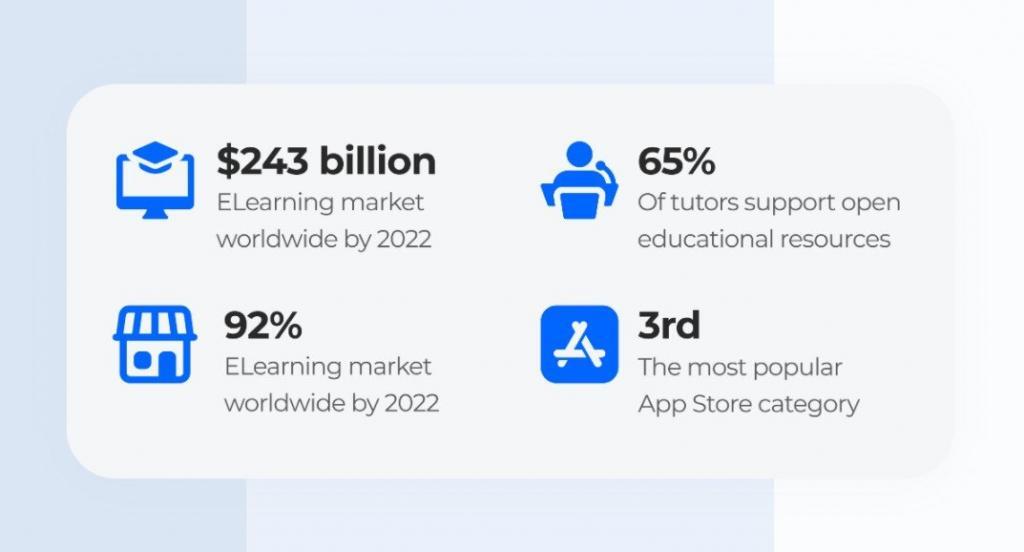
Most experts agree that the main e-learning trends are gamification, foreign language learning, and programming studying applications.
This guide will discuss the detailed description of how to develop an e-learning platform, its cost, features, and solutions stack.
Types of Educational Apps
Educational applications are designed primarily for students or teachers. There is also a more detailed classification according to a variety of purposes and users:
- Kids (Quick Math.Jr, YouTube Kids)
- Tutors (TutorMe, Khan Academy)
- College and university students (eDX)
- Language learners and native speakers (Italki, Duolingo)
- Specialists in various fields (Coursera)
- Lifelong learners (Udemy)
Apps for Teachers
Teachers are offered a fewer range of apps in comparison to learners. Nevertheless, they ease the educating process by allowing them to observe the student’s progress, share it with parents, and set the schedule.

Gamification
Such apps help to attract students’ attention and engage them in the educational process. To illustrate, Kahoot converts the teacher’s quizzes and answers into the game.
Progress Tracking
Such apps enable teachers to check the students’ progress and accomplishments and share them with parents. Additio is a perfect example of such apps. You can observe and operate grades, attendance, and outline schedules.
Educational Material Storage
Cloud storage is a convenient, accessible way for professors and learners for data management. A brilliant popular solution from Google is Google Classroom.
Educational Apps for Students
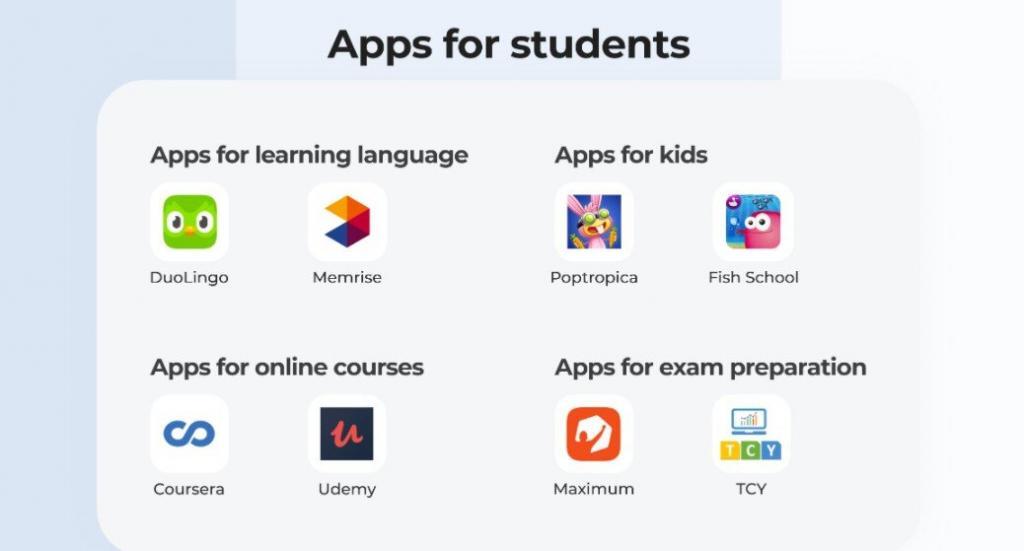
It is a wide range of learning apps that are suitable for various aims. The most sought-after types are listed below:
Language learning apps
The most efficient way to study new languages is to get into the linguistic environment. For this, apps offer to learn in various formats. DuoLingo suggests students take the test to assess their knowledge and Memrise provides videos with native speakers to expand the vocabulary.
Apps for children
The most efficient way for children to obtain new knowledge is to integrate games and education. For instance, Poptropica English asks kids to discover secrets and fulfill English exercises simultaneously.
Apps for online courses
There are applications that offer courses suitable for all preferences, tastes, and fields. They often become partners with educational establishments to provide qualitative learning materials. Coursera and Udemy comprise an enormous number of different courses and convenient categorization to find the most relevant ones.
Apps for exam preparation
Easy-to-use platforms like ExamPrep help to efficiently cope with test preparation by offering quizzes, learning cards, etc. TCY trains students in many fields, like medicine, engineering, MBA/CAT preparation.
Required Features and Technologies
The features may be split into learners’ and tutors’, and also into the essential (MVP), and advanced ones.
Essential Features for Learners
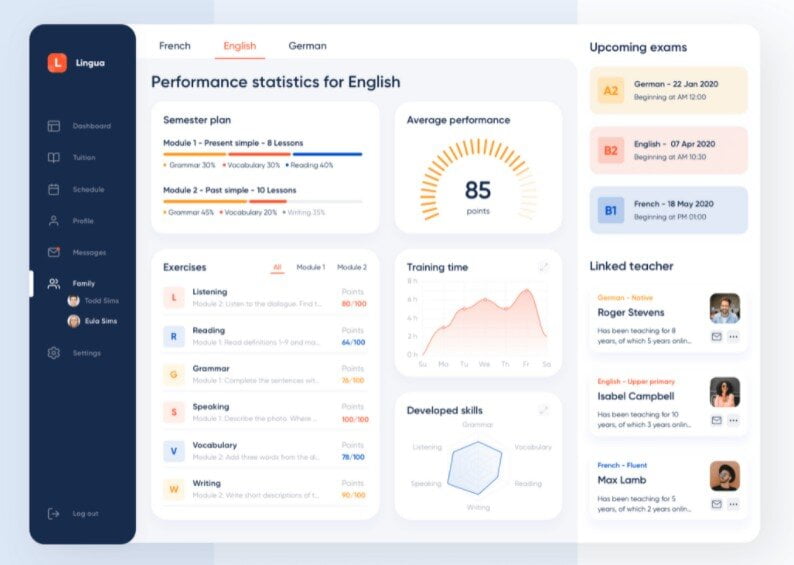
- Registration. To maximize the app’s convenience, you should add signing up with the phone, email and implement the ‘forgot password’ option. Amazon SES and Amazon SNS are used to develop this feature.
- Search. Advanced searching filters should help the users to look for the most relevant solution. ElasticSearch helps to build search systems.
- User profile. This section consists of users’ personal info, courses taken, and progress statistics.
- Course page. Here, learners can find detailed descriptions of each course and a purchasing option.
- Payment methods. Protected and reliable payment service is a must when it comes to in-app purchases. To implement in-app payments, you may add various options like PayPal, Stripe, or Braintree.
- Menu. This screen should show current/finished courses, assignments, upcoming classes and tests, and grades.
- Push notifications. Students may receive reminders concerning today’s timetable, received grades, and tasks. Firebase Cloud Messaging (FCM) is a solution allowing the implementation of push notifications to an app.
Essential Features for Teachers
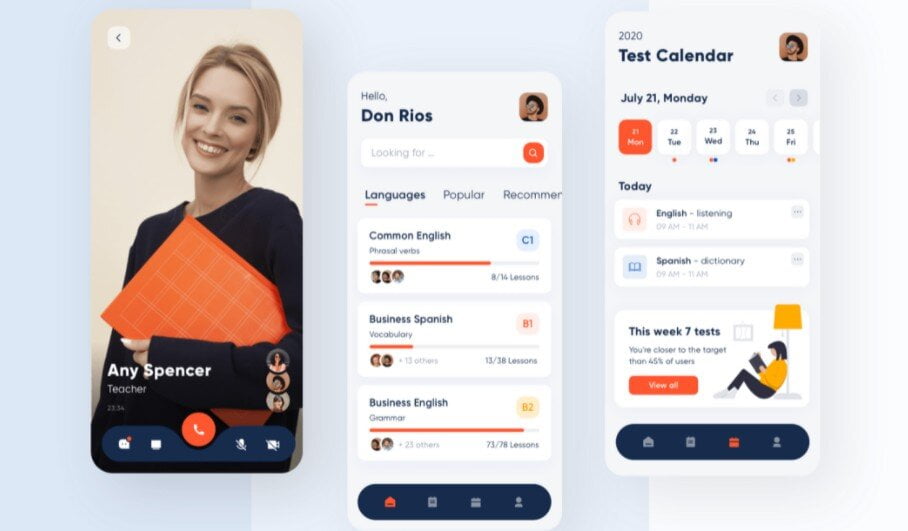
- Registration. The signing up process is similar to the students’. There should be several login options (email/phone). For example, Amazon SES and Amazon SNS allow developing this section.
- Learners management. This screen consists of the student list, their progress, mark, and personal details.
- Course page. From the tutors’ side, this section should allow posting courses and attaching extra materials in different formats.
- Test. To assess the students’ progress on this screen, teachers should add questions and answer options.
- Push notifications. Tutors may get notifications when learners submit tasks or exams. FCM is useful here too.
Team for Educational App Building
Let’s list essential specialists required to develop this type of app for both platforms:
- Business Analyst
- Project Manager
- UI/UX designer
- 1/2 Android developers
- 1/2 iOS developers
- 1/2 Flutter developers (if you apply to Flutter development)
- Back-end developers
- Front-end developers
- QA engineer
Solution Stack
The chosen platform determines the tech stack. Kotlin (Android) and Swift (iOS) are useful for native app development. Flutter is helpful for cross-platform application building.

You can observe an optional tech stack in the illustration below:
Additional Features for Educational App
Extra features broaden the learning methods and make them become more engaging:
- Augmented Reality. By integrating AR into learning, we may observe 3D human skeleton models or dive into the historical past. EON Creation AVR is an instrument allowing you to customize your AR content.
- Virtual Reality. This technology enables interaction with the studying object. The solutions for this are Google VR NDK and VR SDK (for Android and iOS).
- Artificial Intelligence. Apps with AI have a personal approach and a wonderful user experience. For instance, flexible chatbots can talk in foreign languages.
- Gamification. This approach is a perfect way to increase student engagement by adding game elements, such as playing functional, various achievements, levels, rewards, and competitors’ ratings.
How Much Does It Cost to Create an Educational App?
The main factors that impact the cost of making an app are the development time and functional complexity.

MVP features of an Educational App
You can see the approximate development time for each side below (including Flutter for comparison):
Student’s side:
| Feature | Back-end (h) | iOS (h) | Android (h) | Flutter (h) |
| Registration | 47 | 43 | 43 | 45 |
| Search | 26 | 23 | 23 | 23 |
| Profile | 52 | 41 | 41 | 44 |
| Course | 19 | 17 | 17 | 17 |
| Payments | 43 | 36 | 36 | 42 |
| Menu | 88 | 95 | 95 | 1000 |
| Notification | 14 | 14 | 14 | 14 |
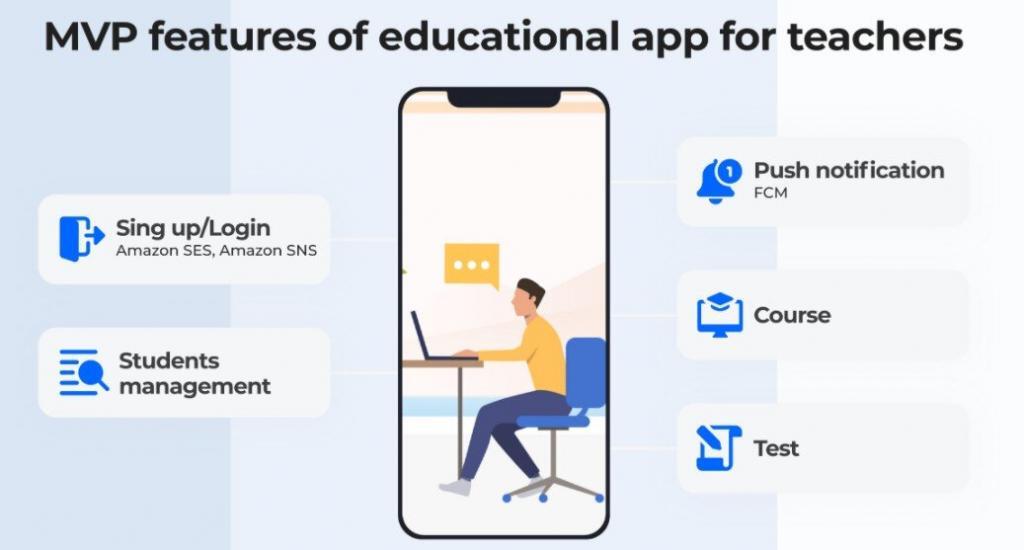
Teacher’s side:
| Feature | Back-end (h) | iOS (h) | Android (h) | Flutter (h) |
| Registration | 47 | 43 | 43 | 45 |
| Student management | 56 | 56 | 56 | 56 |
| Course | 71 | 62 | 62 | 62 |
| Test | 79 | 55 | 55 | 55 |
| Notification | 14 | 14 | 14 | 14 |
Additional Outgoings of Educational App Development
There are also extra expenditures worth covering beforehand:
- Platform. The three main options are Web, Android, and iOS. Cross-platform development doubles the cost, but Flutter decreases both time to market and expenditures.
- Developers’ location. The total cost will vary due to the hourly rate of your partner team. The lowest rates with a high-quality level are in Eastern Europe (for example, in Ukraine), the highest are in North America.
- Design. A user-friendly yet sophisticated UI/UX design is not an easy task, so it approximately requires 120 hours for the one platform and the same number using Flutter for both platforms.
- Admin panel. It allows adding, removing, banning, or editing users and operating payment methods as well. The time required for it is $100 hours and more.
- Quality Assurance. This indispensable stage comprises testing the app to detect and get rid of bugs or any other issues. It takes 1,300 hours on average.
- DevOps. These services automate and maintain the software workflow taking about 200 hours.
| Region | Web developer rates ($) | iOS developer rates ($) | Android developer rates ($) |
| North America | 140 – 150 | 130 – 250 | 150 – 170 |
| Western Europe | 60 – 90 | 40 – 175 | 80 – 100 |
| Eastern Europe | 25 – 50 | 25 – 80 | 35 – 50 |
| Australia | 100 – 150 | 35 – 150 | 110 – 150 |
As was mentioned earlier, the number of hours determines the total cost. For this, we add hours for the backend to iOS/Android/Flutter building hours and multiply this number by the hourly rate.
| Feature | Back-end (h) | iOS (h) | Android (h) | Flutter (h) |
| Learners’ | 289 | 269 | 269 | 285 |
| Teachers’ | 297 | 230 | 230 | 232 |
| Admin panel | 100 | – | – | – |
| Frameworks | 32 | 20 | 20 | 28 |
| Design | – | 120 | 120 | 120 |
| QA | 390 | 455 | 455 | 500 |
| DevOps | 60 | 70 | 70 | 70 |
| Project management | 162 | 189 | 189 | 220 |
| Total | 1 344 | 1 353 | 1 353 | 1 455 |
Educational native app total cost is $134,850, and $202,500 for cross-platform development.
| Platform | Hours | Cost ($) |
| Final (Single platform) | 2 697 | 134 850 |
| Final (Two platforms) | 4 050 | 202 500 |
| Final (Two platforms with Flutter) | 2 799 | 139 950 |
Successful Examples of Educational Apps
DuoLingo
This app allows studying foreign languages, such as English, German, Italian, etc. Its gamification features make learning easy and efficient. Large investors have contributed $148,4 million to this app. Now the number of downloads is over 500 million.
Khan Academy
Each course on this platform is free of charge, has a tutorial with schematic explainings while the voice on the background expounding the details. The invested amount counts as $10,2 million.
Coursera
This platform accesses a great variety of courses with a narrow focus as well. Coursera Marketing allows advancing courses and establishing a brand. The amount of fundings is more than $223 million by now.
Monetization Models in Educational Apps
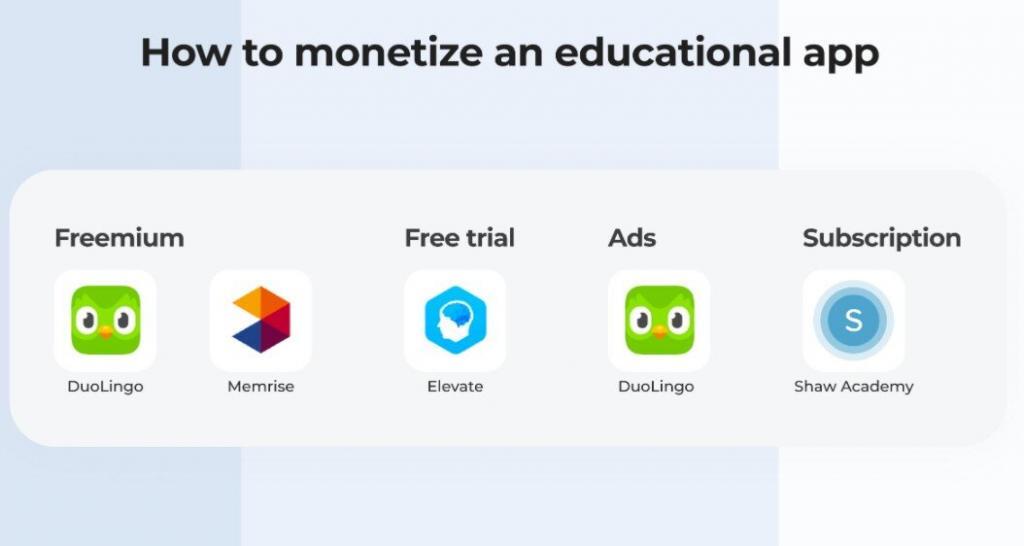
To make the platform profitable, you should choose the one from existing monetization strategies:
- Paid courses. Some platforms access extra features and particular courses for a fee.
- Subscription. There are subscription plans for various periods of time. Paid membership allows access for users to advanced features and courses.
- Ads. If a student uses a platform free of charge, the ad may pop up timely. Learners can’t continue studying the course without watching it.
- Paid application. You may set an adequate cost and make a profit from every download.
Wrapping Up
Observing the market, it is safe to say that educational applications will only have higher demand, so it’s a great startup niche. The wide range of material presenting, broad audience, multiple monetization ways, and so much more peculiarities may be adapted to your requirements. To maximize success possibility you should take no chances and contact a reliable software development company with experience in the e-learning niche.
Related posts:








